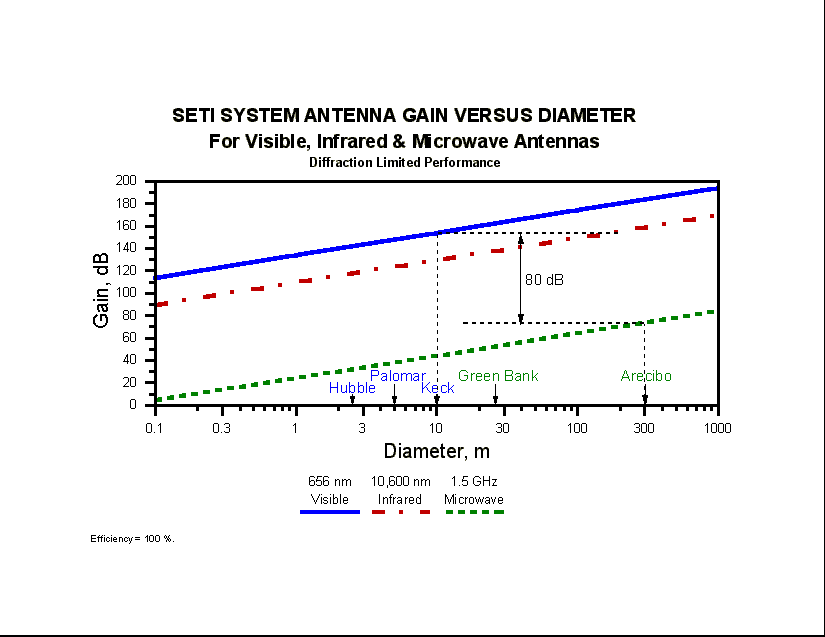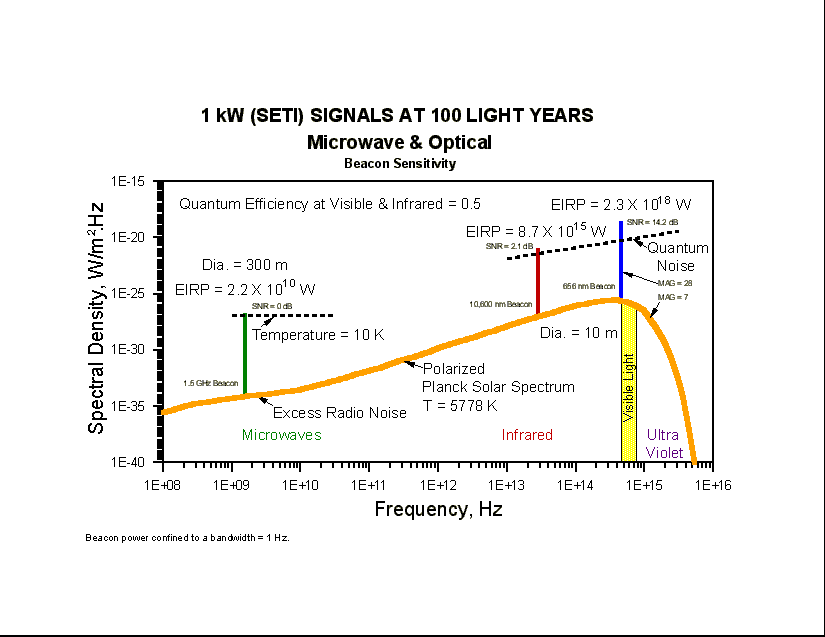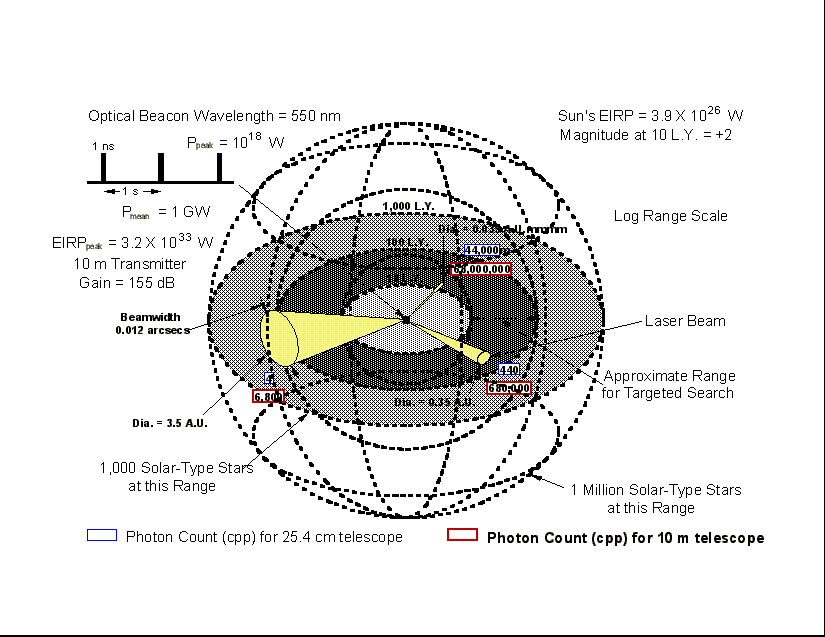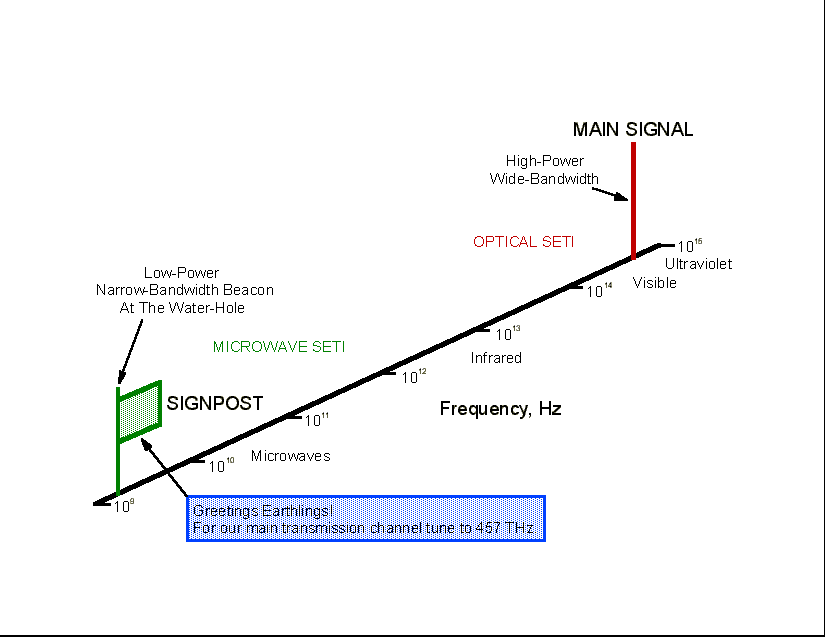Introduction to Optical SETI

 |
In the summer of 1990, the author commenced
revisiting the optical approach to the Search for Extraterrestrial Intelligence (Optical
SETI), an idea almost as old as modern-day Microwave SETI. Star Trek has an
impressive history of stretching the viewer's imagination with regard to the possibilities
that exist out in deep space. The author has long believed in the existence of
Extraterrestrial Intelligence (ETI), an idea that Star Trek's ingenuity has made seem
almost obvious, and hopes that one day it will even become possible for mankind to travel
between the stars - that we will not be locked forever within the confines of our star
system. However, if it is not found to be possible to travel at warp speed, discover
worm holes that might be used as short cuts through the back of the universe or develop
so-called "sub-space communications", then electromagnetic communications will
probably be the only means we have to establish contact with other intelligent
civilizations. Nevertheless, compared with actual space travel, the development of
laser technology by ETIs is trivial and should be non-taxing to their technical prowess.
Free-space laser communication for them would be no more difficult or expensive
than its microwave counterpart. At any rate, in an infinite universe, with infinite
possibilities, it might well be that while some civilizations invent
"warp-speed" technology or discover "worm-holes", others stay home and
just communicate. |

 |
The age of Microwave SETI can be said to have
started in 1959, while the still-born Optical SETI first saw the light of day in 1961.
For various reasons, by the early '70's, SETI rationales became based on the
microwave approach, and the viability of the visible or infrared laser approach had
largely been discounted. A review of the SETI literature of the past 34 years
appears to indicate that the report on "Project Cyclops" had much to do with the
subsequent lack of interest in the optical approach to SETI. The comparisons in that
report between the various forms of electromagnetic SETI severely limited the potential
antenna gain advantage afforded by optical telescopes. In those days, the word
"optical" was still synonymous with the word "visible". However,
over the past two decades, as the fiber-optics industry has matured, "optical"
has been redefined to cover the entire electromagnetic regime from the far-infrared to the
ultra-violet. The technology of "Photonics" or "Optoelectronics"
is the major force that is shrinking our planet today, aka the "Global Village".
It is in this redefined sense that the word "optical" is used here - a
superset of both the visible and infrared regimes. Perhaps within the Milky Way, the
Encyclopedia Galactica is being exchanged between civilizations on an optically-based
Internet, but we have yet to find or establish a node! For sure, the future of
terrestrial communications is one that is largely photonics based. Some time in the
next 30 years, men will for the first time walk upon the surface of Mars. The
historic High Definition (HDTV) pictures of that event will be transmitted back to Earth
via a laser link, probably from the Martian surface to a Martian orbiter via laser, from
the orbiter to Earth via laser and around the Earth via laser-linked geostationary
satellites and into peoples' home via fiber-optics. Truly, the future is photonic.
Photonic for our terrestrially-based future and so too for our space-based future.
To argue otherwise is to fly in the face of reason. |

 |
Initially, the author compared the
effectiveness of free-space interstellar communications using visible and infrared lasers
operating in a very monochromatic continuous wave (cw) mode and with the use of heterodyne
detection techniques, with that of radio-frequency systems. By January 1993, after
communication with Monte Ross, and SPIE's first international conference on Optical SETI,
the author decided to concentrate on the assumption that most ETIs employed pulsed lasers
and that our receiving systems should employ incoherent photon-counting techniques.
It can easily be shown that pulsed lasers are very effective for both beacon signals and
wideband channels. The main advantage is that the high peak to mean power levels,
allow for the received pulses to easily overcome the effects of photon noise caused by the
sky and stellar backgrounds, without the need to employ narrow-band optical filters.
This means that there is no need to postulate a "magic frequency" or "magic
wavelength" - only a "magic wavelength regime". It also obviates the
need to employ complex and expensive coherent optical heterodyne techniques with local
oscillator lasers. |

 |
Sometimes it is overlooked that most
discussion of SETI involves the reception of "beacon signals", not the more
wideband channel that would convey rich data. That there should be some connection
between the "beacon" channel and the "data" channel is often ignored.
It is the latter that will probably govern the placement of both signals in the
electromagnetic spectrum. Indeed, without full consideration of how a wideband
signal can be transmitted over interstellar distances, we are likely to draw erroneous
conclusions about so-called "magic wavelengths or frequencies". |

The above is based on the introduction from Stuart Kingsley's paper in the OSETI II
Proceedings:
|
![]()